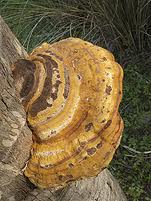Q&ARTISTREE: GETTING TO THE BOTTOM OF GANODERMA BUTT ROT.
Q: Two of my palms have what appear to be yellow mushrooms growing out of the bottom of their trunks. Some of their fronds are yellowing, too. My neighbor says I have butt rot. Can this be true? I’ve never had butt rot but am itching to find out what causes it. Please help.
A: Your neighbor’s right. You do have butt rot. But we’ll help you get to the bottom of it. Here’s what you need to know.
What is it? Ganoderma butt rot is a lethal disease of palms caused by the fungus Ganoderma zonatum. This fungus degrades or rots the lower four-to-five feet of the trunk. All palms are considered hosts of this fungus, but it does not seem to infiltrate any other plant family. Symptoms may include wilting or a general decline.
Causes: What causes Ganoderma to develop is unknown; thus, a palm can’t be diagnosed with Ganoderma butt rot until the conk forms on the trunk or the internal rotting of the trunk is observed. The fungus is spread by spores, which are produced and released from the conk. Currently no cultural or chemical controls exist for preventing or curing the disease.
Additionally, no environmental conditions or landscape management practices have been observed that favor the development of Ganoderma butt rot. The disease occurs in natural settings (palms never transplanted) and in highly-maintained, transplanted landscapes. It occurs on palms that have been maintained very well nutritionally and on palms that were severely stressed by deficiencies. The disease occurs in well-drained settings and in swamps. The fungus has killed trees that had no apparent mechanical injuries and those that had been severely damaged. Soil type appears to have no relationship with disease either; therefore, there are no fungicide recommendations for this disease.
Symptoms: The primary symptom is a mild-to-severe wilting of all leaves but the spear leaf. Other symptoms include slower growth and off-color foliage. However, these symptoms alone should not be used for diagnosis of Ganoderma butt rot since other disorders or diseases may also cause these symptoms. The disease is confirmed by observing the conk on the trunk. A conk is a hard, shelf-like structure (looks like half a mushroom) that is attached to the lower part of the palm trunk; however, not all diseased palms produce conks prior to death.
*Information compiled from Plant Pathology Department, Florida Cooperative Extension Service, Institute of Food and Agricultural Sciences, University of Florida. Monica L. Elliott, professor, Plant Pathology Department, and Timothy K. Broschat, professor, Environmental Horticulture Department, Fort Lauderdale Research and Education Center.
Category Palm Diseases
Tagged with: ganaderma, palm care, palm diseases, spores, butt rott



